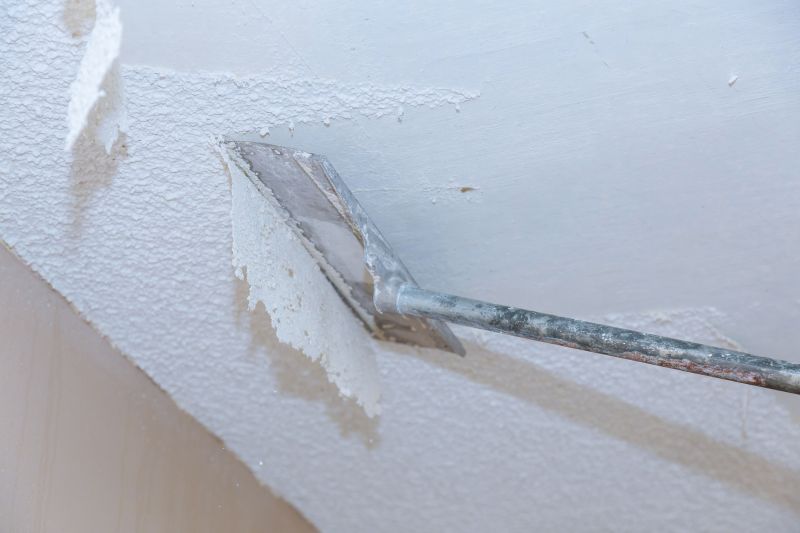Popular Solutions For Textured Ceiling Scrapings You Can Trust
Discover versatile products favored by professionals for effective textured ceiling removal and surface preparation.
 Removing textured ceiling finishes can be a challenging task that requires the right tools and products to achieve a smooth, clean surface. Whether dealing with popcorn ceilings, acoustic textures, or other decorative finishes, selecting appropriate scraping tools is essential to minimize mess and damage. Many products are designed specifically to help loosen, lift, or remove textured coatings efficiently, making the process more manageable for DIY enthusiasts and professionals alike. Proper preparation, including covering furniture and flooring, along with the right scraper or removal system, can significantly impact the ease and quality of the project.
Removing textured ceiling finishes can be a challenging task that requires the right tools and products to achieve a smooth, clean surface. Whether dealing with popcorn ceilings, acoustic textures, or other decorative finishes, selecting appropriate scraping tools is essential to minimize mess and damage. Many products are designed specifically to help loosen, lift, or remove textured coatings efficiently, making the process more manageable for DIY enthusiasts and professionals alike. Proper preparation, including covering furniture and flooring, along with the right scraper or removal system, can significantly impact the ease and quality of the project.
Top Overall Option
Multi-Purpose Ceiling Scraper Kit
This versatile scraper kit offers a range of blades and handles designed for efficient textured ceiling removal. Its ergonomic design helps reduce fatigue during extended use, and the variety of blade types allows for tackling different textures with ease. Suitable for both DIYers and professionals, this kit provides a comprehensive solution for ceiling scraping projects.
Types of Products For Textured Ceiling Scrapings
Manual Ceiling Scrapers
Hand-held tools designed for precise control, ideal for small or detailed areas.
Wide Putty Knives
Large blades that help lift and remove textured coatings with minimal effort.
Oscillating Multi-Tools
Power tools equipped with oscillating blades for faster removal of tough textures.
Electric Ceiling Scrapers
Motorized devices designed specifically for efficient textured ceiling removal.
Scraper Attachments for Drills
Replaceable blades that attach to drills, combining power and control.
Steam Removal Tools
Devices that use steam to soften textured coatings for easier removal.
Chemical Texture Removers
Chemical solutions that loosen textures, often used with scraping tools.
Dust Extraction Systems
Vacuum attachments or systems that help control dust during scraping.
Flexible Blades
Blades that adapt to curved surfaces, ideal for uneven textures.
Heavy-Duty Scrapers
Robust tools designed for removing thick or stubborn textures efficiently.
Handheld Power Scrapers
Portable powered tools for quick and effective scraping.
Paint Scrapers with Sharp Edges
Multi-purpose tools useful for scraping paint and textured coatings alike.
Extension Poles
Tools that extend reach for high ceilings, reducing ladder use.
Detail Scraping Tools
Smaller tools for precision work around edges and corners.
Heat Guns
Devices that soften textures with heat, facilitating easier removal.
Chemical Gel Removers
Gel-based chemicals that cling to textured surfaces for easier scraping.
Popular Choices
Versatile power tools favored for their speed and control in ceiling scraping.
Motorized options that can handle larger areas with less manual effort.
Chemical solutions popular for softening textures before scraping.
Vacuum systems that help contain dust during removal projects.
Commonly used for manual removal and smoothing after scraping.
Helpful for reaching high ceilings without ladders.
Popular for their ability to soften tough coatings with heat.
Reliable tools for stubborn textures that require more force.
Preferred for their ability to cling and soften textures effectively.
Useful for finishing touches and tight corners.
Popular among DIYers for combining power and control.
Favored for their adaptability to uneven surfaces.
Chosen for their chemical-free approach to softening textures.
Multi-use tools often used for prepping surfaces after removal.
Popular for their ease of application and effectiveness.
The market offers a variety of products tailored for textured ceiling removal, from manual scrapers to power-assisted systems. Manual tools often include putty knives, wide scrapers, and specialized ceiling scrapers with ergonomic handles for extended use. Power tools such as oscillating multi-tools or electric scrapers can accelerate the process, especially for larger areas or stubborn textures. Some products come with multi-piece kits that include different blade types and accessories to handle various textures and surface conditions. When choosing a product, consider the texture type, ceiling height, and your comfort level with manual or powered tools.
Proper safety precautions are vital during ceiling scraping projects. Using protective eyewear, masks, and gloves can help prevent inhalation of dust and protect your skin from debris. Additionally, selecting products with features like adjustable blades or cushioned grips can improve safety and comfort during prolonged use. Carefully reviewing product descriptions and user reviews can provide insights into the effectiveness and ease of use of different options, ensuring you select a product that matches your project needs and skill level.
Key Buying Considerations
- Type of ceiling texture to be removed and the appropriate tool for it.
- Ceiling height and whether extension tools are necessary.
- Manual versus powered tools based on project size and personal comfort.
- Ergonomics and handle design to reduce fatigue during prolonged use.
- Dust control features or attachments to minimize mess and health hazards.
- Blade or scraper material for durability and effectiveness.
- Ease of cleaning and maintenance of the tools.
- Compatibility of attachments with existing tools or power sources.
- Safety features such as cushioned grips or adjustable blades.
- Availability of replacement blades or parts for long-term use.
- Project budget and cost-effectiveness of the tool or kit.
- User reviews and ratings to gauge real-world performance.
- Compatibility with other removal methods like heat or chemicals.
- Weight of manual tools and ease of maneuverability.
- Environmental conditions, such as humidity or temperature, that may affect removal.
